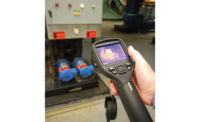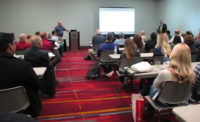The thermostat has evolved — it’s no longer a device that just controls the temperature. Thermostats are connected, attractive, and can help save on energy consumption and cost. Additionally, just like phones and TVs, they’re highly intelligent. With Wi-Fi capabilities, homeowners are able to download apps that allow them to connect to their thermostats to control temperature, check diagnostics, and receive notifications right from their phones, and they can do it from anywhere in the world.
But, just like the efficiency of HVAC equipment depends on a quality installation performed by a professional contractor, the intelligence of smart thermostats depends on proper use and programming performed by an educated consumer.
WATCH AND LEARN
The smart thermostat market is expected to grow rapidly at a compound annual growth rate (CAGR) of 18.7 percent through 2022, according to a report by Grand View Research. One of the major drivers of the market is increased consumer awareness of the economic and environmental advantages of these devices. But, when making the switch from a regular, old thermostat to a smart, brand-new one, contractors across the country are finding that homeowners have some concerns.
“Is it easy to operate?” is the No. 1 question among consumers, according to Paul Sammataro, president, Samm’s Heating and Air Conditioning, Plano, Texas. “We expect our techs to know how to install, setup, and explain [the features] to our clients. Extensive product knowledge is a top priority. If we cannot understand the setup and function [of the thermostat], we are not doing our job properly.”
In order to ensure techs can live up to this expectation, employees at Samm’s attend both manufacturer-led and in-house training sessions.
“We encourage our techs to install a connected thermostat every time there is a thermostat failure,” Sammataro said. “We feel when investing in a new system, it is important to have the system controlled by an up-to-date thermostat. There are rare occasions when clients want to stay with their current thermostat, and we will work with that if it does not affect system operation — for example, when we encounter a two-stage system with an older single-stage thermostat.
“We have our shop connected to our techs’ and sales’ phones to demonstrate connected features,” he continued.
This unique approach, backed by a thorough understanding of the product, has resulted in a connected thermostat being sold and installed by Samm’s employees 98 percent of the time.
While Sammataro looks to real-time demos to entice and reassure homeowners of the reliability and features of a connected device, Rich Biava, vice president of Gaithersburg, Maryland-based GAC Services and his team have found another “smart” approach.
“One of the things we have done is explain the main thermostats and put them on YouTube, so customers can reference them,” said Biava. “The videos range from 10-20 minutes and cover how, why, and when to use each of features available on the particular thermostat highlighted. GAC began this service just a couple of years ago, but, in that time, its videos have been viewed thousands of time. This has been a huge help in educating our customers but also in training our personnel.”
CUSTOMER SATISFACTION
When customers purchase high-end communicating equipment, it requires a compatible communicating thermostat. If this is the case, customers have no choice but to purchase a new thermostat as well. However, in some instances, it may not be necessary.
“On a replacement installation, we strongly encourage that we install a new thermostat,” said Butch Welsch, president, Welsch Heating & Cooling Co., St. Louis. “In addition, most of the manufacturer’s make it a requirement to utilize one of their thermostats in order for the consumer to receive the manufacturer rebates.”
Though newer thermostats are less susceptible to failure and they offer several conveniences to the homeowner, there are some drawbacks as well.
“It is our general policy not to install a programmable thermostat unless specifically requested by the customer,” said Welsch. “The reason for this is that so many consumers do not understand or want to program their thermostats. When they don’t know how, this can frequently result in a nuisance service call to reset the program.”
Sammataro agrees that problems do arise when customers don’t understand how to use the new thermostats, and customer satisfaction can take a beating because of this. In an effort to be proactive, technicians at Samm’s Heating and Air Conditioning perform mandatory quality checks. After an install, technicians check in with the homeowners to ensure they feel comfortable with their level of understanding in terms of setup and operation of the thermostat. This significantly helps to cut down on callbacks, according to Sammataro.
“We feel there is no downside to installing connected thermostats, and it allows for many other opportunities for automation,” he said. “Most [consumers] are enjoying the ability to have the added feature of operating their thermostats from anywhere in or out of their homes.”
At GAC Services, smart thermostats are just part of the package when it comes to a system replacement or install.
“Some homeowners want just basic equipment and don’t want Wi-Fi thermostats,” said Biava. “They are older and may not have a smartphone. Some older people switch, but they don’t use it the way it is intended. It’s fine, but they use it like the old stat.”
THE WAY OF THE FUTURE
Smart thermostats are the gateway to smart homes, which are no longer a thing of the future. The future has arrived, and many believe HVAC contractors who want continued success will be the ones who are mastering the new technology and, in turn, educating their customers on the benefits of using these features.
“We train our guys on new thermostats and how to use them,” said Biava. “We have companies come in to discuss them, and we become the expert.”
But the training and education can’t stop there.
“Our technicians and installers typically attend at least one class a year where the various thermostats we offer are discussed along with information regarding installation and troubleshooting as well as providing operating information to the customers,” said Welsch. “Some of the newer communicating thermostats require some extra instruction. And while the class described above is worthwhile, most of the training and understanding of the thermostats comes as hands-on training on the job site.
“It’s hard to predict what a consumer’s questions will be, so the technicians need to be ready for anything,” Welsch continued.
There’s no denying that society is becoming more connected and that there are benefits to all the capabilities available from just the touch of a screen. However, there is reason for concern as well, according to Welsch.
“For example, placement of the thermostat is very important for the proper comfort in the home,” he said. “Needing to have the stat put someplace easier for the homeowner to operate the other functions may be detrimental to the true thermostat operation. We feel the important thing is that we make sure that the thermostats we provide to customers are the ones that are right for them and that they can be easily operated as intended.”
Publication date: 10/23/201
Want more HVAC industry news and information? Join The NEWS on Facebook, Twitter, and LinkedIn today!








